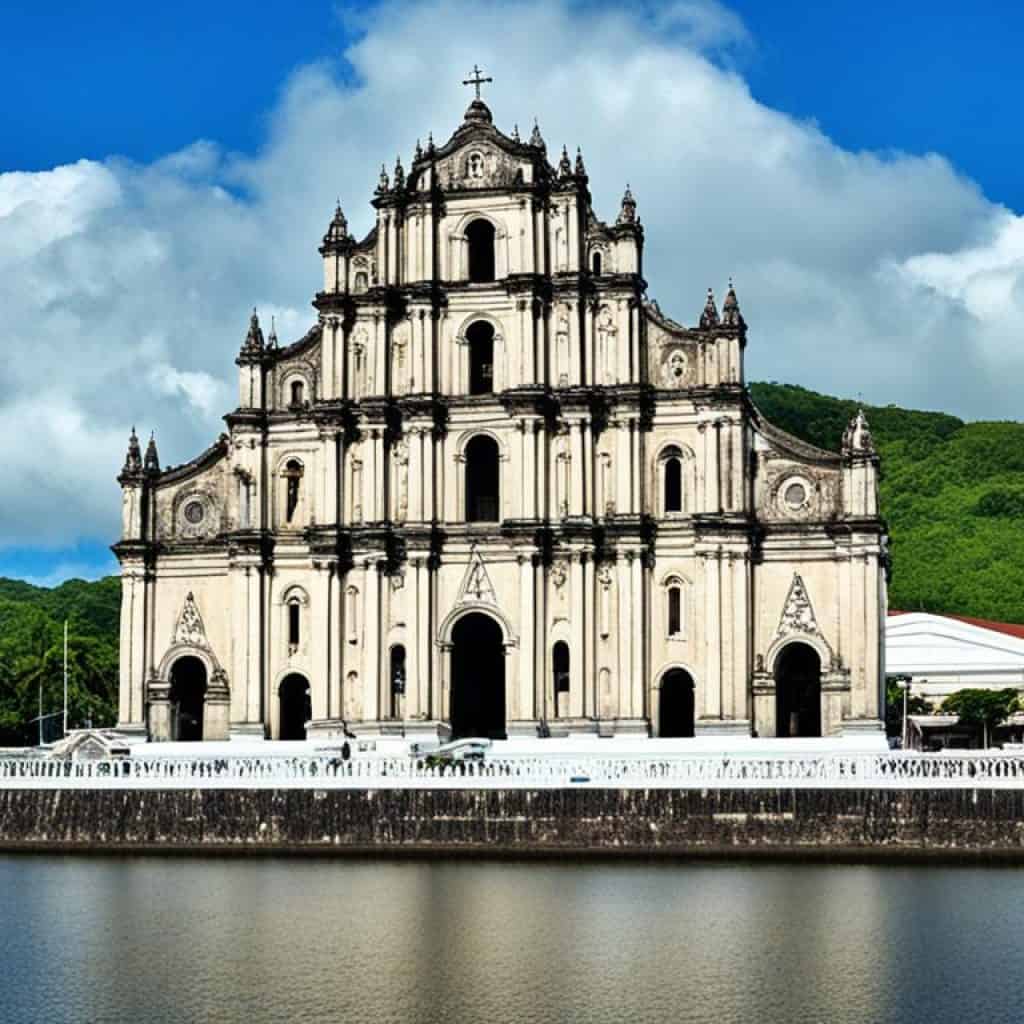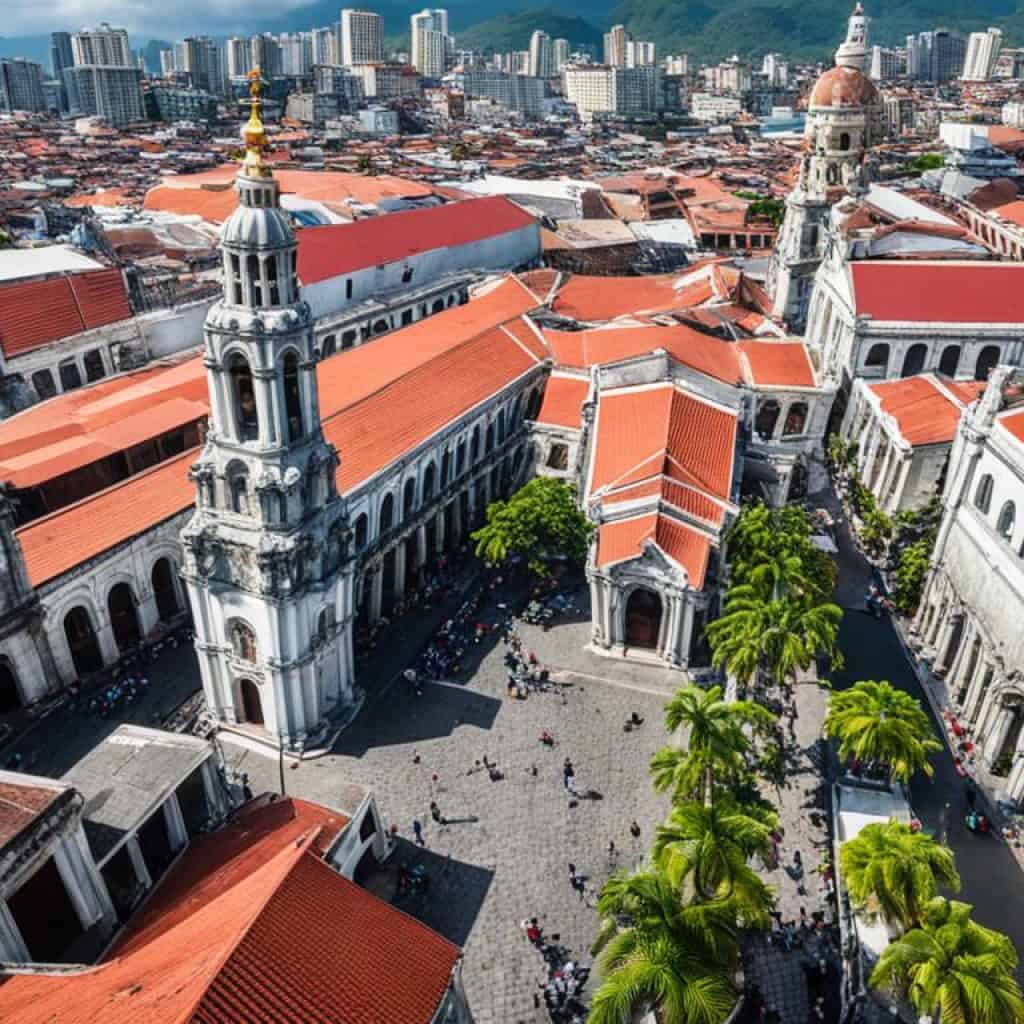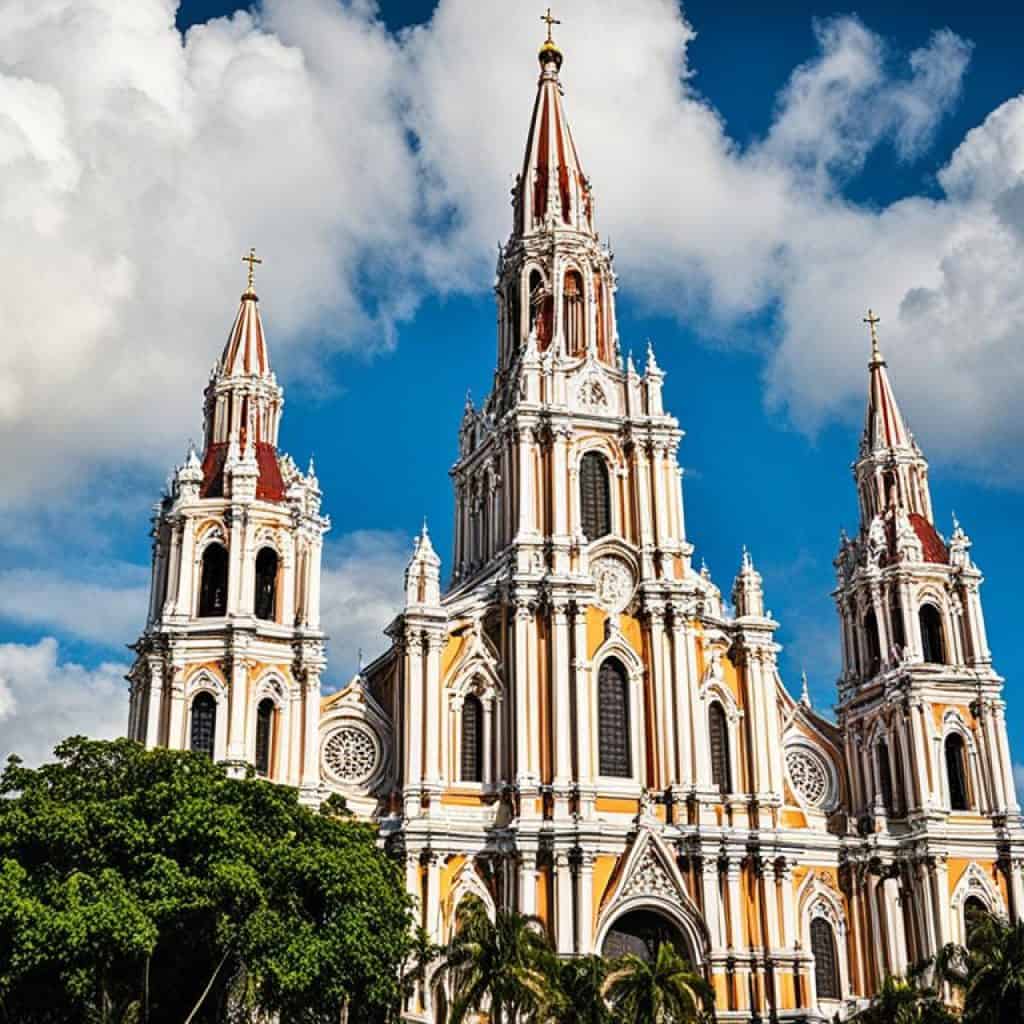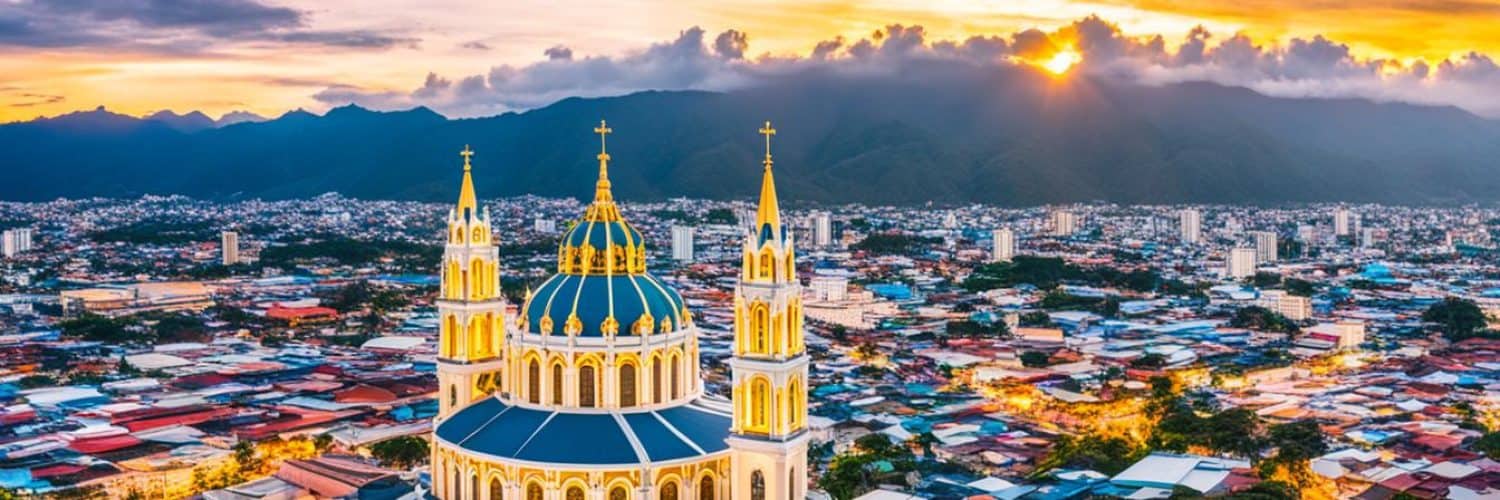When it comes to famous churches in the Philippines, one stands head and shoulders above the rest. But can you guess which one is the biggest? Prepare to be amazed as we unveil the grandeur of the Taal Basilica, the largest church not only in the Philippines but also in all of Asia. Get ready to immerse yourself in the rich history, architectural beauty, and cultural significance of this iconic cathedral.
Key Takeaways:
- Taal Basilica is the largest church in the Philippines and Asia, capturing the attention of visitors with its grandeur.
- Constructed in the 19th century, Taal Basilica showcases the enduring faith and architectural prowess of the Filipino people.
- With its distinctive Baroque-style facade and intricate interior, Taal Basilica is a top tourist destination in the Philippines, offering insights into the country’s cultural heritage.
- Taal Basilica holds great religious and cultural significance, serving as a place of worship, a site for pilgrimages, and a symbol of the Filipino people’s enduring faith.
- Exploring Taal Basilica and other famous churches in the Philippines offers a glimpse into the rich history, architectural beauty, and religious importance of these cultural landmarks.
The History of Taal Basilica
The town of Taal has a rich history dating back to the 16th century when it was founded by Augustinian missionaries. The first church in Taal was constructed in 1575 but was destroyed by a volcanic eruption in 1754. The current Taal Basilica was built in the 19th century after the earthquake of 1852 destroyed the previous church. The construction of the new church was completed in 1878, making it the largest church in the Philippines at that time. Today, Taal Basilica stands as a testament to the enduring faith and architectural prowess of the Filipino people.
Architectural Features of Taal Basilica
Taal Basilica, an iconic church building in the Philippines, is celebrated for its impressive architectural features that make it one of the top tourist sites in the country. This renowned church boasts a Baroque-style facade adorned with 24 classical columns arranged in pairs.
The combination of its triangular roof and gables showcases the influence of Chinese and Javanese architectural styles, adding to its unique charm and making it a remarkable example of Philippine church architecture.
Stepping inside Taal Basilica, visitors are greeted by the grandeur of the main altar standing 24 meters high. This magnificent centerpiece is adorned with magnificent statues of saints and angels. The intricately painted patterns and designs throughout the church’s interior create a visually stunning atmosphere that captivates all who enter.
“The beauty of Taal Basilica lies not only in its sheer size but also in the meticulous details that grace its architecture. Every element, from the columns to the statues, tells a story and showcases the rich cultural heritage of the Philippines.”
The architectural prowess of Taal Basilica has made it a must-visit destination for architecture enthusiasts, history buffs, and spiritual seekers alike. It stands as an iconic symbol of Philippine church architecture, attracting visitors from around the world. Its grandeur and historical significance make it an integral part of the cultural fabric of the Philippines.
Significance and Cultural Importance of Taal Basilica
Taal Basilica holds great religious and cultural significance in the Philippines. As a religious landmark in the Philippines, it serves as a place of worship for the Catholic community, providing a sanctuary for prayer, devotion, and spiritual solace. The basilica is not only a place of personal reflection but also a site for important religious ceremonies and pilgrimages.
With its historical and architectural value, Taal Basilica has earned the esteemed status of a National Shrine. It stands as a proud symbol of the enduring faith of the Filipino people and carries the weight of the country’s history on its shoulders. Despite facing natural disasters and wars throughout the years, the basilica has remained resilient, a testament to the strong spiritual connection and unwavering determination of the Filipino people.
As one of the most famous churches in the Philippines, Taal Basilica has become an iconic representation of Philippine church architecture. Its remarkable beauty and cultural importance captivate visitors from around the world. The basilica draws individuals not only for its religious significance but also as a testament to the rich heritage and traditions deeply ingrained in Filipino culture.
Taal Basilica: A Witness to History
“Taal Basilica stands tall as a witness to the country’s storied past, displaying its magnificent architecture and fervent devotion amidst the test of time.” – Anonymous
Through the years, Taal Basilica has weathered the challenges of changing times. It has stood firm and proud, surviving earthquakes, volcanic eruptions, and the tumultuous events of history. The basilica’s ability to withstand these trials showcases its resilience and cultural significance as a living testament to the faith of the Filipino people.
The architectural brilliance of Taal Basilica, with its intricate details and grandeur, is an embodiment of the creativity and artistry of the Filipino people. It serves as a reminder of the remarkable achievements of the past, drawing admiration and awe from all who visit.
Furthermore, Taal Basilica holds a special place in the hearts of the locals, serving as a focal point for community gatherings, celebrations, and festivities. The church’s role in fostering a sense of belonging and unity among the Filipino people is invaluable.

In summary, Taal Basilica’s significance as a religious landmark, its architectural beauty, and its cultural importance make it one of the most famous churches in the Philippines. As a symbol of the enduring faith and resilience of the Filipino people, it stands as a beacon of inspiration and a testament to the rich heritage of Philippine church architecture.
Visiting Taal Basilica
When planning a trip to the Philippines, one cannot miss the opportunity to visit Taal Basilica, one of the top tourist sites in the country. This magnificent cathedral, also known as the largest church in the Philippines, offers visitors a chance to experience the grandeur of Filipino religious architecture.
Upon entering Taal Basilica, visitors are immediately struck by the awe-inspiring interior adorned with intricate artwork and stunning designs. The atmosphere is serene and spiritual, inviting guests to take a moment to reflect and appreciate the beauty of the surroundings.
To enhance the visit, guided tours are available, offering valuable insights into the history and significance of Taal Basilica. Knowledgeable guides provide interesting facts and stories about the cathedral, allowing visitors to deepen their appreciation for its cultural and religious importance.
Exploring the town of Taal itself is also a delightful experience. With its well-preserved Spanish colonial architecture and charming streets, Taal exudes a nostalgic ambiance. Visitors can take leisurely strolls through the heritage town, immersing themselves in the rich history and culture of the Philippines.
Additionally, there are nearby museums where visitors can further indulge their curiosity about the region’s past. From the Taal Heritage Center to the Galleria Taal, these museums offer a glimpse into the traditions, arts, and stories of the area.
No visit to Taal would be complete without sampling the local delicacies. The town is famous for its mouthwatering treats, such as the iconic Balisong Cookies and sumptuous Batangas Bulalo. Food enthusiasts will surely delight in the distinctive flavors and culinary delights that Taal has to offer.
A visit to Taal Basilica is not just a sightseeing experience – it is a journey into the heart of the Philippines’ cultural heritage. The combination of the magnificent cathedral, the captivating town, and the delicious cuisine creates a memorable adventure that will leave a lasting impression on every traveler.
Other Famous Churches in the Philippines
While Taal Basilica is the biggest church in the Philippines, there are many other famous churches worth exploring across the country. These include:
1. San Agustin Church, Manila
Known for its Baroque architecture and UNESCO World Heritage status, San Agustin Church in Manila is a testament to the Philippines’ rich history and religious heritage. Its intricate design and ornate interior make it a must-see attraction for visitors.
2. Miagao Church, Iloilo
The Miagao Church in Iloilo is renowned for its sculptural relief carvings and its history as a stronghold against Muslim raiders. The church’s unique architectural style and cultural significance make it a fascinating destination for history enthusiasts.
3. Paoay Church, Ilocos Norte
Located in Ilocos Norte, the Paoay Church is known for its distinct Baroque architecture and its designation as a UNESCO World Heritage site. The church’s massive sandstone structure and intricate details make it an architectural marvel.
4. Binondo Church, Manila
The Binondo Church in Manila, also known as the Minor Basilica of St. Lorenzo Ruiz, is one of the oldest churches in the country. Its elegant design and historical significance make it a popular place of worship and a significant religious landmark.
5. Barasoain Church, Bulacan
The Barasoain Church in Bulacan is known for its role in Philippine history as the birthplace of the First Philippine Republic. Its colonial architectural style and connection to the country’s struggle for independence make it an important cultural site.
Each of these churches showcases unique architectural styles, historical significance, and cultural heritage, making them must-visit destinations for travelers interested in exploring the famous churches of the Philippines.

Religious Tourism in the Philippines
The Philippines is a popular destination for religious tourism, attracting both locals and international visitors who seek to explore the country’s famous churches and religious sites. Among the most significant events for religious tourism is the Holy Week, particularly the practice of Visita Iglesia. During this observance, pilgrims journey to multiple churches to engage in prayer and reflection.
This unique tradition allows visitors to immerse themselves in the spiritual atmosphere of the Philippines and appreciate the beauty and historical significance of its churches. From the intricate architectural designs to the rich cultural heritage, these religious sites offer a meaningful travel experience that deepens one’s connection with their faith.
“Religious tourism provides a unique opportunity for visitors to appreciate the rich history and spirituality of the Philippines.”
Visiting famous churches such as Taal Basilica and other historical church structures in the Philippines allows travelers to witness the country’s enduring religious heritage. These landmarks serve as iconic representations of the Filipino people’s deep-rooted faith and cultural identity.
Top Tourist Sites in the Philippines for Religious Tourism
- 1. Taal Basilica in Batangas, the biggest church in the Philippines.
- 2. San Agustin Church in Manila, a UNESCO World Heritage site.
- 3. Miagao Church in Iloilo, known for its sculptural relief carvings.
- 4. Paoay Church in Ilocos Norte, featuring Spanish colonial architecture.
- 5. Binondo Church in Manila, a historical landmark.
- 6. Barasoain Church in Bulacan, known for its significant role in Philippine history.
Exploring these famous churches provides not only a glimpse into the architectural brilliance of Philippine church structures but also a deep appreciation for their historical and cultural value. Religious tourism in the Philippines offers a remarkable journey where visitors can nourish their spirits, explore top tourist sites, and learn about the country’s fascinating religious traditions.
Importance of Catholicism in the Philippines
Catholicism holds a special place in the hearts of the Filipino people, shaping their culture and religious identity. Introduced by the Spanish during the colonial period, Catholicism has become the largest Christian denomination in the country. With one of the largest Catholic populations in Asia, the Philippines is home to countless century-old churches that serve as living testaments to the enduring religious heritage.
At the forefront of these religious landmarks stands the magnificent Taal Basilica, the largest Christian church in the Philippines. This cathedral in the Philippines is not only a physical representation of Catholicism’s influence but also a symbol of the Filipino people’s strong faith.
“Catholicism has become an integral part of the Filipino culture, influencing their beliefs, traditions, and way of life. The towering presence of Taal Basilica serves as a reminder of the lasting impact of Catholicism on the nation.”
As the dominant religion, Catholicism continues to shape the lives of Filipinos. Churches, like Taal Basilica, hold a central role in the daily lives of the people. They serve as places of worship, community gathering, and spiritual solace. These religious landmarks are not only symbols of Catholicism’s presence but also cultural institutions that foster a sense of unity among the Filipino people.
Through their rich architectural history and spiritual significance, churches in the Philippines, including Taal Basilica, contribute significantly to the preservation of cultural and religious identity. They serve as beacons of hope and strength, inspiring generations to uphold their faith and heritage.
The Cultural Significance of Taal Basilica
Named a religious landmark in the Philippines, Taal Basilica is not only significant in terms of its religious value but also its cultural importance. It stands as a testament to the enduring faith and unwavering spirit of the Filipino people throughout history.
This largest Christian church in the Philippines has witnessed the country’s triumphs and struggles, surviving earthquakes and other natural disasters. It stands as an unwavering reminder of the strength of the Filipino people, their resilience, and their profound connection to their religious beliefs.
Through its grandeur and historical presence, Taal Basilica invites people from all walks of life to immerse themselves in the rich tapestry of Philippine culture and heritage. It symbolizes the intersection of tradition, spirituality, and architectural magnificence, leaving visitors in awe of its beauty and cultural significance.
The Power of Faith in the Philippines
The overwhelming presence of Catholicism in the Philippines reflects the power of faith in the lives of the people. It shapes their worldviews, values, and societal norms, contributing to the unique Filipino identity.
With more than 80% of the population identifying as Catholics, the influence of Catholicism extends beyond religious practices. It permeates various aspects of Filipino life, including celebrations, festivals, and even governance.
The deep-rooted faith of the Filipino people acts as a unifying force, fostering solidarity and a sense of belonging. Churches, such as Taal Basilica, provide a spiritual sanctuary where individuals can find peace and solace in times of joy, sorrow, and uncertainty.
The Role of Taal Basilica and Other Churches
Taal Basilica, as the largest church in the Philippines, serves as a shining example of the enduring faith and rich cultural heritage present throughout the country. It reminds us of the indomitable spirit of the Filipino people and the power of religion in shaping their lives.
Moreover, Taal Basilica and other churches across the Philippines showcase remarkable architectural designs that have become a hallmark of the country’s cultural heritage. They attract tourists from around the world, not only for their religious significance but also for their awe-inspiring beauty and historical value.
| Section | Key Points |
|---|---|
| Catholicism in the Philippines | – The Spanish introduced Catholicism to the Philippines during the colonial period. – It is now the largest Christian denomination in the country. – The Philippines has one of the largest Catholic populations in Asia. |
| Taal Basilica’s Cultural Significance | – Taal Basilica represents the enduring faith and unwavering spirit of the Filipino people. – It has survived earthquakes and other natural disasters, becoming a symbol of strength. – Taal Basilica invites visitors to experience Philippine culture and heritage. |
| The Power of Faith | – Catholicism influences not just religious practices, but also celebrations, festivals, and governance. – Faith acts as a unifying force, fostering solidarity and a sense of belonging. – Churches provide spiritual sanctuary and serve as pillars of strength in times of joy, sorrow, and uncertainty. |
| Role of Taal Basilica and Other Churches | – Taal Basilica exemplifies the enduring faith and rich cultural heritage of the Philippines. – It attracts tourists with its remarkable architecture and historical value. – Churches like Taal Basilica are integral to preserving the country’s cultural and religious identity. |

Future Preservation and Restoration Efforts
Preserving and restoring historical churches is of utmost importance to safeguard the cultural and architectural heritage of the Philippines. Organizations and government agencies are actively working together to ensure the structural integrity of these iconic structures while preserving their historical and artistic elements.
Through collaborative restoration projects, these churches, including the magnificent Taal Basilica, are being protected for future generations to appreciate and enjoy. By investing in the preservation of these churches, the Philippines continues to showcase its rich history and cultural legacy in Philippine Church Architecture.
The efforts to preserve and restore historical churches in the Philippines are multifaceted and involve various aspects, such as architectural assessments, conservation of materials, and documentation of historical features. Skilled professionals, including architects, engineers, historians, and craftsmen, contribute their expertise to ensure the authenticity and longevity of these cultural treasures.
Restoration projects also play a significant role in job creation and skills development, stimulating the local economy and empowering communities. The preservation of historical churches not only safeguards their physical structures but also contributes to the promotion of tourism and cultural appreciation.
Challenges and Opportunities
Preserving and restoring historical churches in the Philippines is not without its challenges. The passage of time, natural disasters, and human activities can degrade the structural integrity and artistic elements of these churches. Limited financial resources and the need for specialized skills further complicate the preservation efforts.
However, these challenges also present opportunities for innovation and collaboration. Creative approaches, such as the use of advanced technologies and sustainable practices, can be employed to overcome preservation hurdles. Partnerships between government agencies, private organizations, and local communities can bring together diverse resources and expertise to ensure the continued preservation and restoration of these invaluable cultural landmarks.
Promoting Cultural Heritage
The preservation and restoration of historical churches in the Philippines not only enhance their physical longevity but also promote cultural heritage and identity. These churches serve as tangible links to the past, representing the architectural achievements and religious devotion of previous generations. By preserving them, the Philippines honors its rich history while sharing it with a global audience.
Preserving historical churches not only protects our heritage but also educates future generations about the importance of cultural legacy and identity.
Visitors to these restored churches have the unique opportunity to experience the grandeur of Philippine Church Architecture, marvel at intricate details, and gain a deeper understanding of the country’s religious and cultural heritage. Through guided tours, interactive exhibits, and community involvement, these churches become living museums, providing a platform for cultural exchange and appreciation.
Looking Towards the Future
The future of preserving and restoring historical churches in the Philippines depends on continued commitment, collaboration, and support. By recognizing the intrinsic value of these cultural treasures and investing resources in their maintenance, the Philippines can ensure that future generations will have the privilege of exploring and admiring these magnificent structures.
As the Philippines embraces sustainable development and cultural preservation, the preservation of historical churches remains a vital aspect of national pride and cultural identity. By safeguarding these churches, the Philippines showcases its unique architectural heritage and contributes to the global appreciation of historical and religious landmarks.
Conclusion
The Taal Basilica in the Philippines stands as a true masterpiece of Philippine church architecture. As the largest church not only in the country but also in all of Asia, it exudes an aura of grandeur and magnificence. The impressive size, exquisite architectural features, and rich historical significance of the Taal Basilica make it a must-visit destination for both tourists and locals.
Together with other famous churches in the Philippines, the Taal Basilica represents the enduring faith and cultural identity of the Filipino people. Exploring these iconic religious landmarks allows visitors to immerse themselves in the rich history and beauty of Philippine church architecture.
Whether you are a tourist seeking to discover the top sights of the Philippines or a local looking for spiritual solace, a visit to the Taal Basilica and other renowned churches is an enriching experience. You will be captivated by the breathtaking beauty, intricate details, and the deep-rooted significance of these religious gems. Take the time to appreciate the legacy of the Philippine church architecture and witness the inspiring devotion of the Filipino people.
FAQ
What is the biggest church in the Philippines?
Where is Taal Basilica located?
When was Taal Basilica built?
What architectural style is Taal Basilica?
What is the significance of Taal Basilica?
What can I see inside Taal Basilica?
What are some other famous churches in the Philippines?
What is religious tourism in the Philippines?
What is the importance of Catholicism in the Philippines?
How is the preservation and restoration of historical churches like Taal Basilica being carried out?
Source Links
- https://www.thepoortraveler.net/2012/04/basilica-de-san-martin-de-tours-taal-batangas/
- https://news.abs-cbn.com/ancx/travel/best-lists/04/18/19/going-on-visita-iglesia-this-holy-week-include-one-of-these-beautiful-churches-in-your-itinerary
- https://guidetothephilippines.ph/articles/history-culture/must-visit-philippine-churches


















Add comment